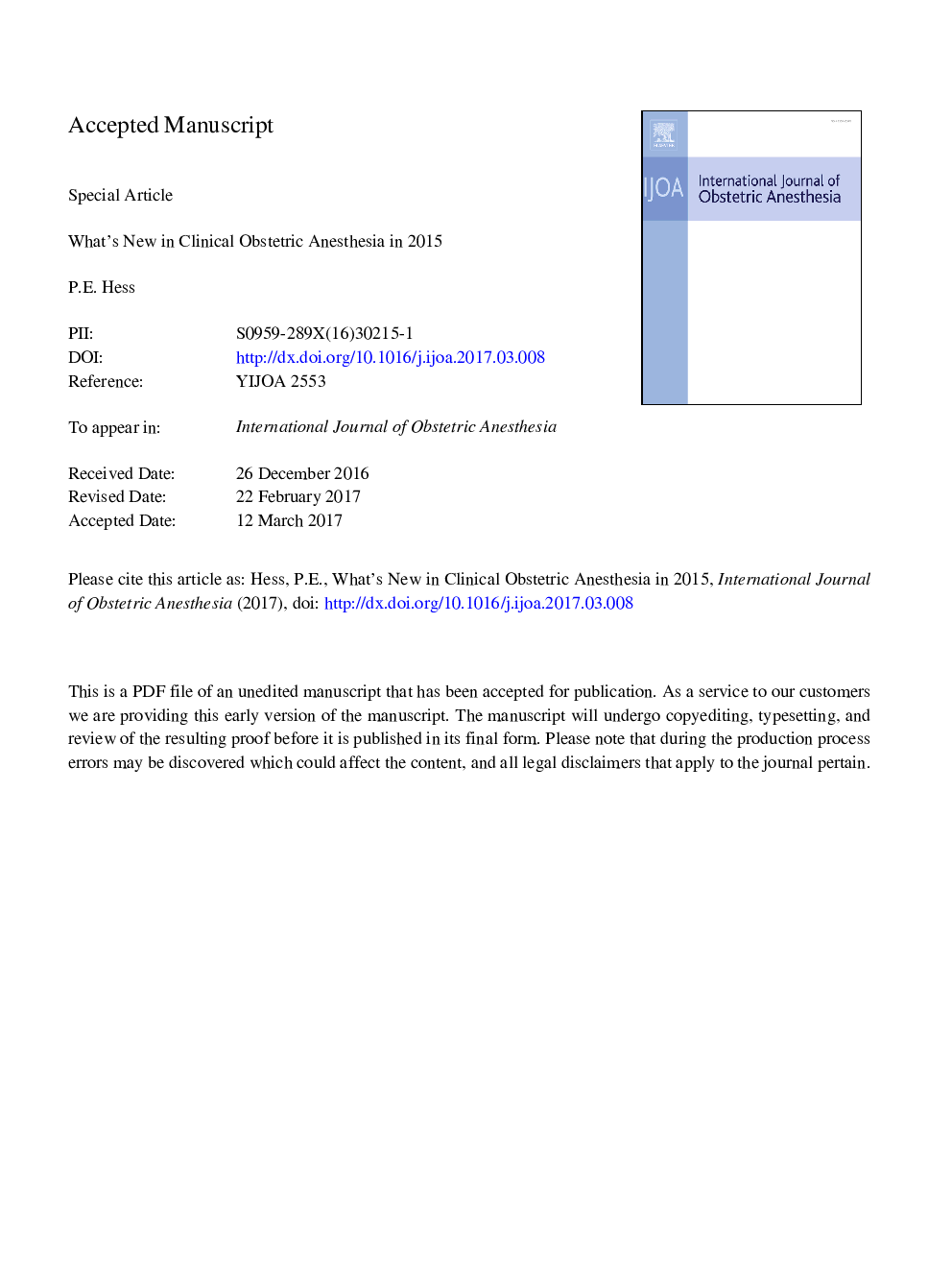| کد مقاله | کد نشریه | سال انتشار | مقاله انگلیسی | نسخه تمام متن |
|---|---|---|---|---|
| 5582112 | 1567502 | 2017 | 23 صفحه PDF | دانلود رایگان |
عنوان انگلیسی مقاله ISI
What's new in clinical obstetric anesthesia in 2015?
ترجمه فارسی عنوان
چه جدید در بیهوشی بالینی مامایی در سال 2015؟
دانلود مقاله + سفارش ترجمه
دانلود مقاله ISI انگلیسی
رایگان برای ایرانیان
کلمات کلیدی
بیهوشی نخاعی، بی حسی اپیدورال، سردرد دائمی سوراخ سوراخ، تب مادری،
ترجمه چکیده
در هر سال تقویم، انجمن بیهوشی و پریناتولوژی زنان و زایمان، فرد را دعوت می کند تا بررسی ادبیات پزشکی را انجام دهد، شناسایی نشریات مرتبط با بالینی مربوط به ارائه کننده بیهوشی زایمان. این گزارش از این تلاش ها انتشارات سال 2015 را پوشش می دهد و شامل دسته های بیهوشی و درد زایمان، عوارض روش های نوروزی و اثرات بیهوشی در جنین می شود. روشهای غیر روحی بیانگر بنیاد بیهوشی مامایی است؛ پیشرفت در بیهوشی و درد زایمان شامل شیوه های جدید مدیریت و پالایش در مراقبت از بیمار پیچیده پزشکی است. علاوه بر بروز درد زایمان، تحقیقات در زمینه بهبود پس از سزارین، چالش هایی در کنترل درد، بیماران مبتلا به آپنه انسدادی خواب و پروتکل های درمان در نظر گرفته شده برای بهبود مراقبت از بیماران، به ویژه مسیر پیشرفته بهبود می یابند. از آنجا که عوارض اجتناب ناپذیر است، در این بررسی، بررسی عوارض شایع عوارض غیرطبیعی، مانند فشار خون، برادیکاردی مادر و جنین، و سردرد پس از دوقطبی مشخص می شود. چندین گزارش نوآورانه برای مقابله با این عوارض وجود دارد، از جمله استفاده از تزریق نوراپی نفرین برای جلوگیری از فشار خون ناشی از اسپینال، افدرین برای جلوگیری از برادی کوردی جنین پس از ترکیب درد زخم اپالوزی اپالورال و درمان فارماکولوژیک سردرد پانکراس بعد از دیالیز. همه این درمان ها موفق نبودند. در نهایت، اثرات بالقوه بیهوشی در مغز جنین / نوزادی وجود دارد، که بیشتر آنها هنوز مشخص نیست. تجزیه و تحلیل مقالات اخیر نشان می دهد که تب اپیدورال مستقل از آسیب عصبی عضلانی جنین نیست. از سوی دیگر، شواهد همچنان رشد می کنند تا از این فرضیه حمایت کنند که داروهای بیهوشی بر پیامدهای نورولوژیکی نوزاد اثر می گذارد.
موضوعات مرتبط
علوم پزشکی و سلامت
پزشکی و دندانپزشکی
بیهوشی و پزشکی درد
چکیده انگلیسی
Each calendar year the Society for Obstetric Anesthesia and Perinatology invites an individual to conduct a review of the medical literature, identifying clinically relevant publications of interest to the obstetric anesthesia provider. This report of that effort covers the publications from 2015 and includes the categories of anesthesia and analgesia, complications of neuraxial procedures, and the effects of anesthesia on the fetus. Neuraxial procedures represent the foundation of obstetric anesthesia; advances in anesthesia and analgesia include novel modes of administration, and refinements in care of the medically complex patient. In addition to labor analgesia, investigations into post-cesarean recovery address challenges in pain control, patients with obstructive sleep apnea, and treatment protocols intended to improve patient care, notably an enhanced-recovery pathway. Because complications are inevitable, this review identifies investigations on the more common complications of neuraxial procedures, such as hypotension, maternal and fetal bradycardia, and post-dural puncture headache. There were several innovative reports attempting to address these complications, including the use of norepinephrine infusion for the prevention of spinal-induced hypotension, ephedrine for the prevention of fetal bradycardia after combined spinal-epidural analgesia, and pharmacologic treatment of post-dural puncture headache. Not all of these treatments were successful. Finally, there are potential effects of anesthesia on the fetal/neonatal brain, much of which remains poorly defined. An analysis of recent papers suggests that epidural fever is not an independent cause of adverse neurologic fetal injury. On the other hand, evidence continues to grow to support the hypothesis that anesthetic drugs impact neonatal neurologic outcome.
ناشر
Database: Elsevier - ScienceDirect (ساینس دایرکت)
Journal: International Journal of Obstetric Anesthesia - Volume 32, November 2017, Pages 54-63
Journal: International Journal of Obstetric Anesthesia - Volume 32, November 2017, Pages 54-63
نویسندگان
P.E. Hess,
